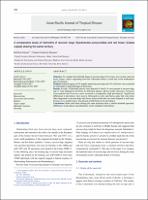Показать сокращенную информацию
A comparative study of helminths of raccoon dogs (Nyctereutes procynoides) and red foxes (Vulpes vulpes) sharing the same territory
| dc.contributor.author | Schuster, Rolf Karl | |
| dc.contributor.author | Shimalov, Vladimir Vasilievich | |
| dc.date.accessioned | 2020-09-17T07:16:46Z | |
| dc.date.available | 2020-09-17T07:16:46Z | |
| dc.date.issued | 2017-11-29 | |
| dc.identifier.citation | Schuster, R. K. A comparative study of helminths of raccoon dogs (Nyctereutes procynoides) and red foxes (Vulpes vulpes) sharing the same territory / R.K. Schuster, V.V. Shimalov // Asian Pacific Journal of Tropical Disease. – 2017. – Vol. 7, iss. 12. – P. 708–714. | ru_RU |
| dc.identifier.issn | 1995-7645 | |
| dc.identifier.uri | https://rep.brsu.by:443/handle/123456789/163 | |
| dc.description.abstract | Objective: To compare the helminth fauna of raccoon dogs (Nyctereutes procynoides) and red foxes (Vulpes vulpes) originating from the Uckermark distict, a rural area in the northeastern part of Germany. Methods: Internal organs of 101 legally hunted raccoon dogs and 144 red foxes were examined for helminths by helminthological dissection. Results: In total, 18 helminth species were detected of which 14 were present in raccoon dogs and 17 were detected in red foxes. In both host species, Mesocestoides litteratus, Uncinaria stenocephala and Toxocara canis occurred in comparably high prevalences. Significant differences in prevalence were seen in Isthmiophora melis and Alaria alata that were more often diagnosed in raccoon dogs and Taenia polyacantha that was more frequent in red foxes. Echinococcus multilocularis was present in both hosts in low prevalence. Conclusions: Both canid hosts sharing the same territories have a similar helminth spectrum. Differences in prevalence and abundance can be explained with distinct. | ru_RU |
| dc.language.iso | en | ru_RU |
| dc.publisher | Medknow Publications | ru_RU |
| dc.title | A comparative study of helminths of raccoon dogs (Nyctereutes procynoides) and red foxes (Vulpes vulpes) sharing the same territory | ru_RU |
| dc.type | Article | ru_RU |
